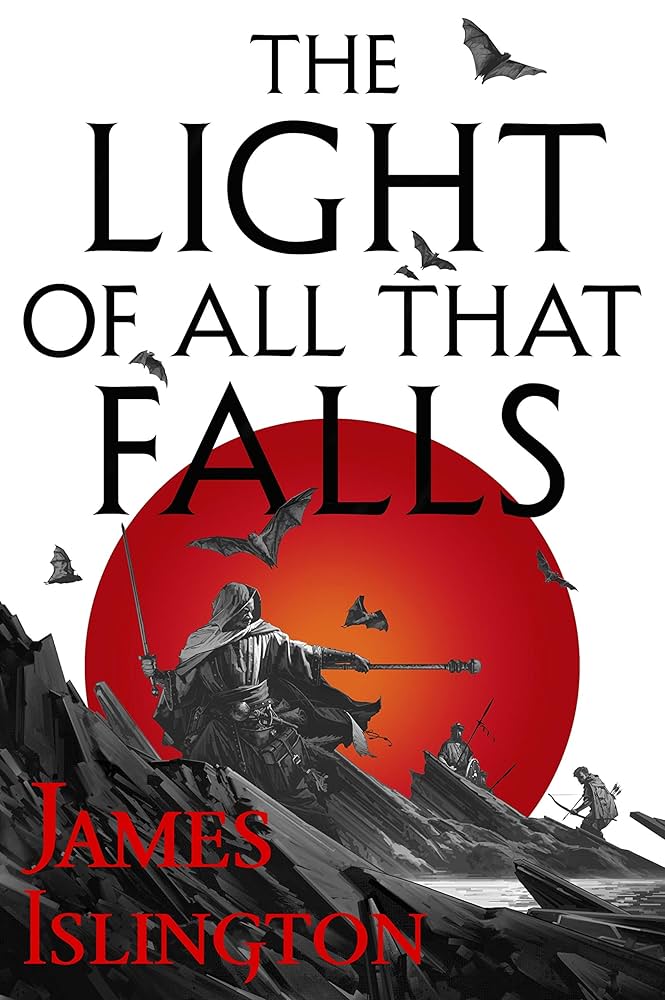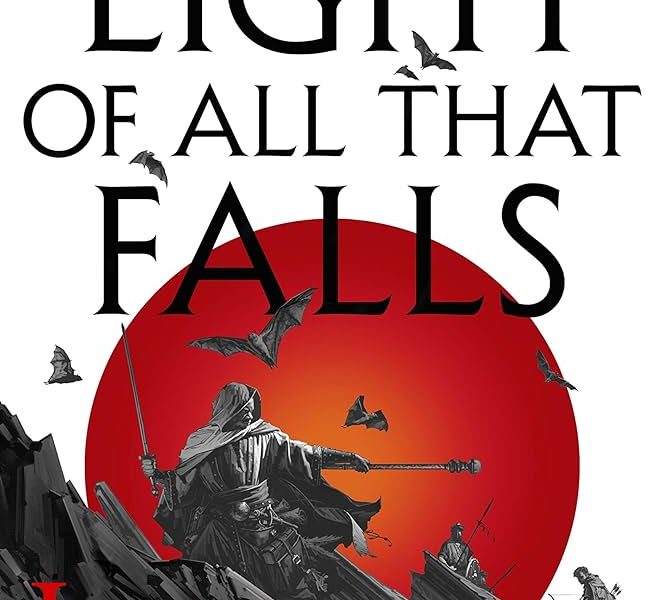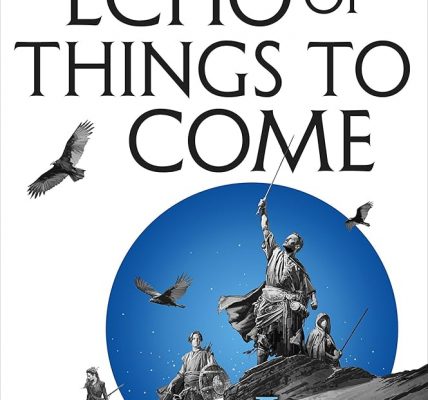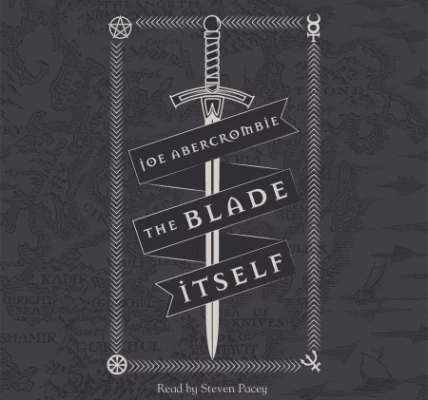
The climactic end of James Islington’s debut trilogy comes together like a Scooby-Doo stamp sandwich: packed with all the meat, lettuce, cheese, and assorted fillings, but squeezed between two soggy slices of bread. It might be a tasty bite, sure—but it doesn’t hold together well enough to earn the kind of ending it’s going for.
The Light of All That Falls is a really fun story. But it’s not a story that earns its ending. Characters should go through struggle and strife—overcoming real obstacles or failing tragically—to reach a conclusion that feels not just satisfying, but rewarding. Islington’s ending might be a comfortable one for fans of predictability, but the story itself feels like it’s sprinting toward the finish line, hoping we won’t notice the stumbles along the way.
The Beginning of the End
The book picks up about a year after An Echo of Things to Come. By now, we know Aarkein Devaed is Caeden, and that Caeden was once part of the Venerate—immortal Augurs who thought they were working for a god (El), but were actually doing the bidding of the demon Shammaeloth. Classic mix-up.
As before, the story’s split across four main narratives.
Davian’s story follows him post-boundary crossing, now at the mercy of the Venerate. With limited access to kan and essence, and the knowledge that he’s fated to travel back in time to die at the hands of his friend, his journey is shaped by grim certainty—but he uses that to his advantage.
Sent to a city outside of time (because why not?), Davian hones his powers and prepares to become the hero he’s meant to be, hoping it’s not all in vain. His path takes him back to Tal’Kamor and a final reveal: the truth about his origins.
Meanwhile, Caeden—his present self—is scrambling to complete his master plan and shut the Rift at Deilannis for good. With Shammaeloth lurking and waiting to break through, Caeden must gather every weapon he can, including the sword Licanius, to sever all ties to kan itself. But even as his schemes unfold, others are playing their own games. Nethgalla, the demon in the form of his wife, appears to be helping… but Caeden knows better. Her intentions are anything but pure.
While Davian and Caeden face the heart of Talan Gol, Wirr is holding the line back in Andarra. As Banes (those foul chimeran nightmares) cross the boundary and Desriel threatens invasion, Wirr steps up—reluctantly, but necessarily. The son of the Northwarden now must wield power he never wanted, using the Oathstone hidden by his father, and lead Andarra to war.
Wirr’s story is all about becoming the leader no one expected. Administrator, Gifted, general—he’s all of it now. With a fragile coalition of soldiers, Gifted, and politicians, he has to pull it together or everything falls apart.
Asha, meanwhile, is still in the Tributary, now supercharged with essence and power beyond anything we’ve seen before. With access to the memories and abilities of every shadow ever made, she prepares for the final showdown—but fears she may be too late. When the Venerate come for her, she knows time is running out. She must break free and join her friends—and Davian, the love of her life—for the final stand.
An Unworthy Conclusion
Now, The Light of All That Falls should be a sweeping, action-packed finale. Something to close this world’s doors with a bang and maybe open a few windows for Islington’s future projects. And hey—maybe it is for some people. But for me? It feels unfinished. Like a polished second draft when we should’ve gotten the third.
When I started The Shadow of What Was Lost, I noticed right away that the characters were a little rough around the edges. But I held out hope that they’d grow into themselves. And to be fair—some of them did. There’s fun to be had here. There’s depth in watching people challenge their beliefs, and a solid critique of blind faith and dogma.
And yet, there isn’t quite enough to have me believing these characters truly evolve. While they take on new roles—becoming leaders, generals, powerful magic users—their experiences rarely change them in any way beyond gaining new skills.
Seriously. That’s how almost every character develops. Wirr becomes a better general. Davian becomes an Augur as powerful as the Venerate. Asha becomes a master of manipulating essence. This doesn’t feel like character development—it feels like leveling up in an RPG.
Let’s be real: Caeden/Tal’Kamor is the character. He’s the Arthurian archetype with a twist—pulling the sword from the stone and carrying centuries of dark history. He’s heroic, villainous, tragic, hopeful, heartbreaking. He’s it. He’s the only truly rounded character across three books. Everyone else? Side characters in what should’ve been his story. The Venerate and Tal’Kamor shouldn’t be footnotes or flashbacks—they should’ve been front and center.
Is Our Side the Just Side?
Caeden’s story is fraught with questions of identity, morality, and theology. His journey is forever uncertain. For every moment he fights against Shammaeloth, we wonder if that’s truly the enemy he’s fighting.
Some of the best moments in this book are the ones that question whether Caeden’s side is the right side. His dialogues with his former allies delve into theology, belief, and moral compromise. These aren’t just fantasy arguments—they’re genuinely thoughtful explorations of what it means to act justly, and whether cruelty is ever excusable if it’s done in the name of the greater good.
Can someone be good if their actions are led by self-interest? Can someone still be just if they’re wrong about who they serve?
Theology is at the heart of this series—and it should be beating louder. Unfortunately, most characters approach their faith with unwavering certainty. If they’re with the Venerate, they believe they serve El. If they’re with Caeden, they believe the Rift must be sealed and Shammaeloth kept out. Only Caeden is given the space to question his beliefs and change because of it.
In Conclusion
This book is 800 pages long—but it still doesn’t feel like enough. The finale lacks impact because it’s so predictable. You’ll see most of it coming a mile away. And while that’s not inherently bad—comfort has its place—I think Islington had earned the right to surprise us. He’s done it before.
He’s built puzzles and revealed them piece by piece in brilliant ways. I just wanted more of that.
There’s a lot to enjoy in The Light of All That Falls: big battles, freedom fights, love, revenge, heartbreak. The building blocks are there—they’re just never assembled into something greater than the sum of their parts. Islington built his house on a strong foundation but fell short in expressing what that house was meant to be.
In the end, The Licanius Trilogy is a comfortable read. It’s enjoyable, easy to fall into, and doesn’t demand too much of the reader. But if you’re looking for something more challenging—something that pushes characters to their limits and gives side characters the depth they deserve—this might not quite deliver.
Final Score: 6.8/10





